Frames are not the only gilt items to benefit from professional care, our gold leaf experts work with a wide variety of antique and modern pieces. Applied by hand using centuries old techniques, gilding can be finished to a level that suits the historic appeal of an object or revived to its original grandeur.
 Above: a selection of gilded items including an armchair, wall clock and standing Buddha
Above: a selection of gilded items including an armchair, wall clock and standing Buddha
This article will explore the care of many gilt items, from baroque motifs and mantle clocks to ornate chairs, tables and interiors.
What is gilding?
Gilding is the application of gold leaf to a surface – typically wood, gesso, metal, plaster, porcelain or stone. This process achieves an impressive metallic finish at a fraction of the cost and weight compared with solid gold. You may also come across gilt objects finished in silver or bronze.
 Above: detail of a gilt wall relief figure, 18th century
Above: detail of a gilt wall relief figure, 18th century
Gilt surfaces are often found on the following items:
- Picture frames
- Mirror frames
- Sculptures
- Gates and fences
- Interior relief decoration
- Wall sconces
- Candlestick holders
- Chandeliers
 Above: a selection of gilt antiques including a pair of torchère figures, an armchair, a church sculpture, mantle clock, chandelier and Chelsea teapot
Above: a selection of gilt antiques including a pair of torchère figures, an armchair, a church sculpture, mantle clock, chandelier and Chelsea teapot
- Clocks
- Porcelain
- Furniture
- Asian screens
- Certificates
- Trinket boxes
- Historic shop signs
- Mixed media art
Gold leaf is hammered from a nugget of gold, creating sheets that are around 0.1 micrometre thick. Gilding is usually completed with 22 carat gold to prevent tarnishing.
 Above: gilt relief decoration surrounding a Boucher panel, 1753
Above: gilt relief decoration surrounding a Boucher panel, 1753
Gold leaf application
For a perfect finish, gilding should be applied by a skilled craftsman or conservator. Traditionally, gold leaf is set into place using water or oil. Determining whether gilding is water or oil-based will help in its preservation and restoration.
 Above: our conservator applying gold leaf
Above: our conservator applying gold leaf
In many cases, oil gilding may have been used to historically repair water gilding, as this is a slightly easier method. Oil gilding uses a varnish-like paste to apply the gold leaf to a sealed surface, whilst water gilding introduces several further steps to produce a suitable surface before the gold leaf is introduced, including the additions of a gesso and glue base. Gilding can be assessed and tested by our conservators to establish the methods used.
A gilt object may have a red tone beneath the surface to give it a warm base. This colour may show through as the gilding layer becomes abraded and lost over time. Some antiques have purposefully worn areas to give an aged effect.
 Above: our conservator Amelia adding an aged finish to a newly gilt frame
Above: our conservator Amelia adding an aged finish to a newly gilt frame
Caring for gilt objects
For everyday care, a gilt object can be gently cleaned and dusted with a light and dry cloth. It is important not to push or scrub the gilded areas, as this will lead to abrasions or loss of detail.
 Above: a selection of gilt decorative objects and mouldings
Above: a selection of gilt decorative objects and mouldings
Golden features on ceilings and other interior embellishments will require maintenance from a professional who is knowledgeable about gold leaf and its vulnerabilities. Amateur cleaning techniques can lead to disaster, so make sure that the work is carried out by an experienced conservator. A light and dry dusting of a ceiling or feature are recommended, but professional intervention is required for any build-up of discolouration, dust, soot, or grime.
 Above: a decorative gilt mount before and after cleaning and restoration
Above: a decorative gilt mount before and after cleaning and restoration
Instead of attempting to remove any layers of dirt at home, contact our team for professional and sensitive cleaning techniques. Where a frame has worn down or become discoloured over the years, our conservators can expertly reapply suitable gold leaf traditionally by hand.
 Above: gilt decoration halfway through cleaning in our studio
Above: gilt decoration halfway through cleaning in our studio
When caring for gilded wooden items it is important to avoid wet cleaning methods, such as household products and even water. If a piece is water gilded this will easily rub away the gold leaf and leave a bare surface. If accidental spills, leaks, or flooding occur, allow the piece to dry naturally and contact our team as soon as possible. Water gilding is especially vulnerable to this and maybe completely lost if cleaned or damaged with a water-based solution.
 Above: a gilt motif with contrasting levels of gold leaf finish
Above: a gilt motif with contrasting levels of gold leaf finish
Environmental issues
Whilst gilt details can last for hundreds of years, they may easily degrade in modern environments. Allowing a gilt object to be frequently touched will lead to continuous abrasion. A busy location that could result in knocks or bumps should be avoided. A quiet space is always preferable for sensitive antiques.
 Above: chairs with gold leaf frames are some of the most worn and abraded gilt antiques
Above: chairs with gold leaf frames are some of the most worn and abraded gilt antiques
Areas of lost gilding and broken gesso can let in airborne contamination and moisture to the unprotected, underlying wood. Airborne contamination may be acidic if it includes fireplace smoke, soot, pollution or nicotine. Breakages will encourage the surrounding details to fall away, worsening over time. When the overall structure is loose and vulnerable it should be dealt with promptly by a conservator to prevent decay.
 Above: two guéridon and a side table with gilt decoration
Above: two guéridon and a side table with gilt decoration
Our team can reapply various forms of gilding, whether this is an ornate piece or flat surface. The reapplication of gold leaf will add an extra barrier to the object, helping to stabilise the structure as well as returning its original appearance.
 Above: decorative objects with aspects of gold leaf
Above: decorative objects with aspects of gold leaf
How can we help?
If you have a damaged item with gold leaf decoration or a similar surface, please speak to our team today for advice on professional restoration. Email us via [email protected] or call 0207 112 7576

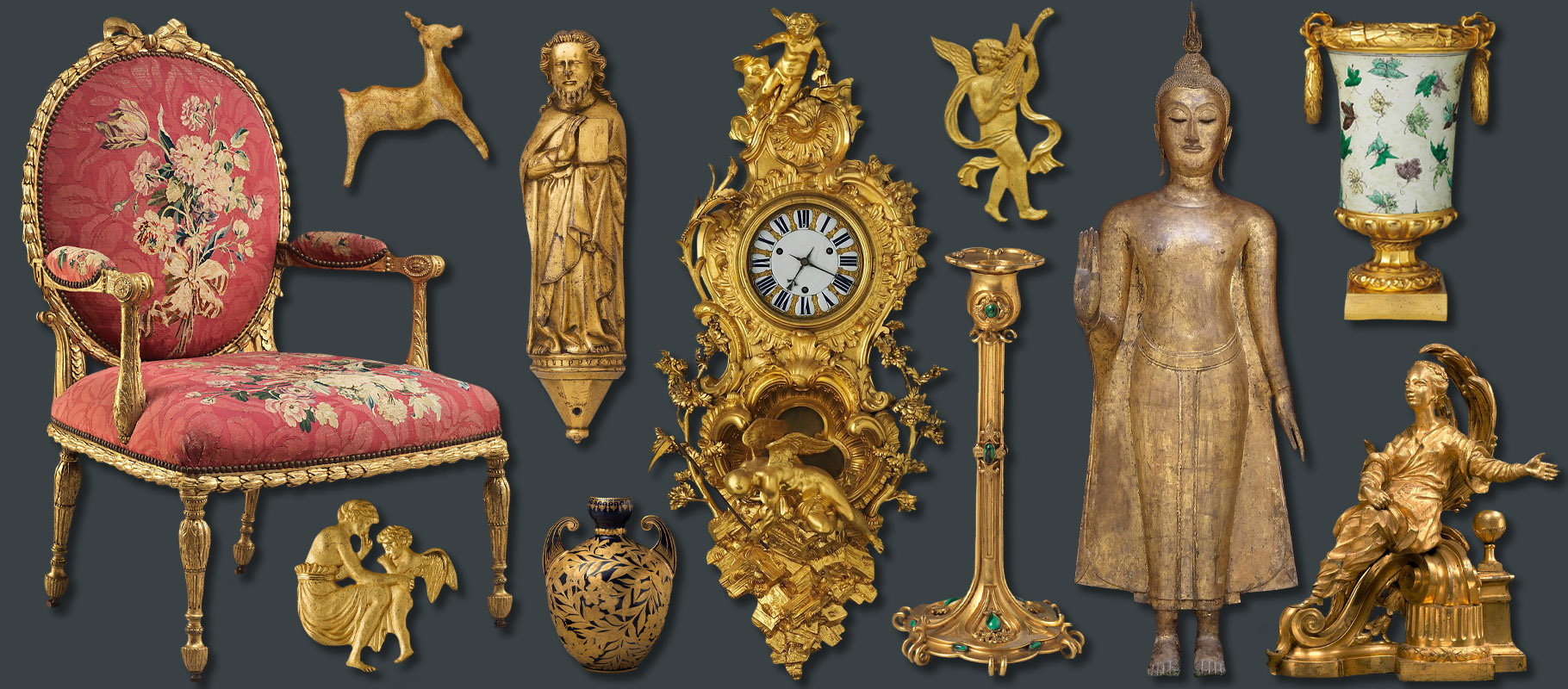 Above: a selection of gilded items including an armchair, wall clock and standing
Above: a selection of gilded items including an armchair, wall clock and standing 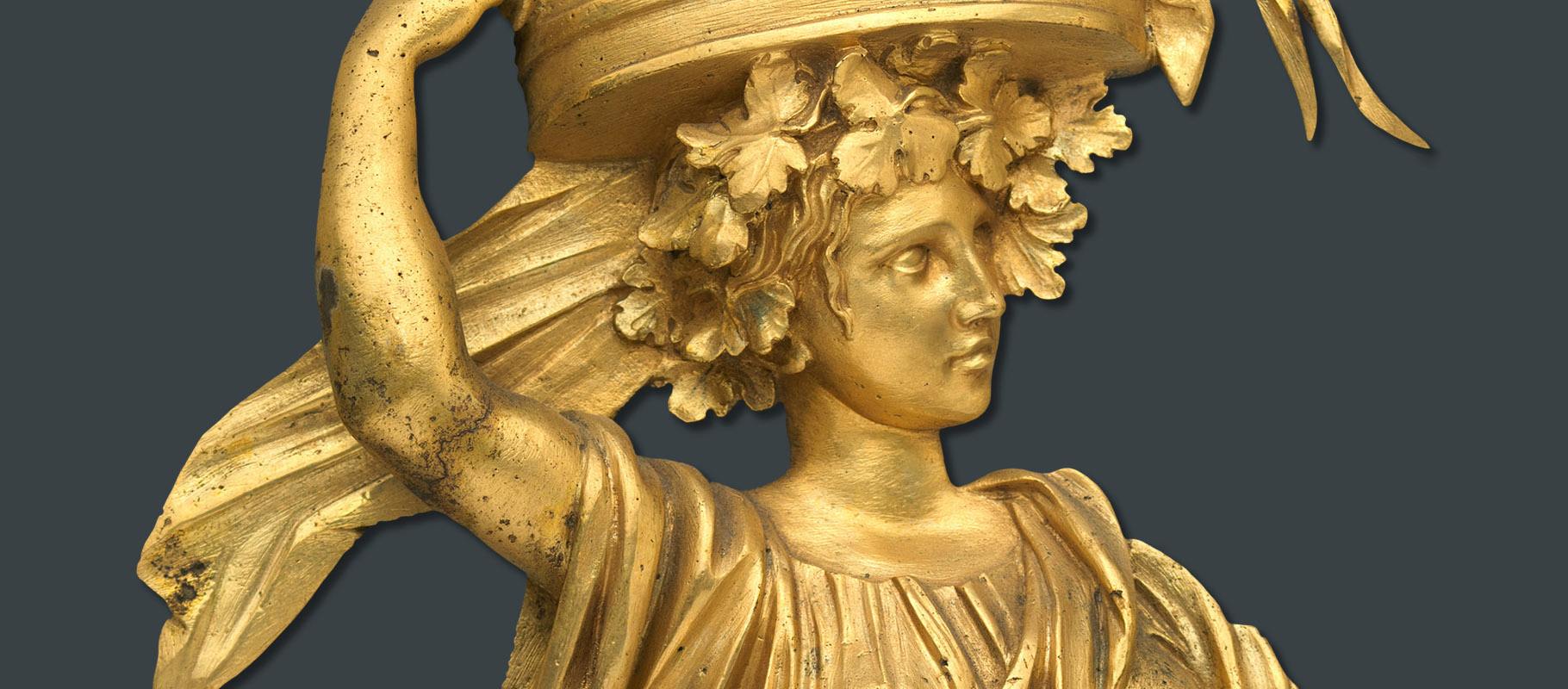 Above: detail of a gilt wall relief figure, 18th century
Above: detail of a gilt wall relief figure, 18th century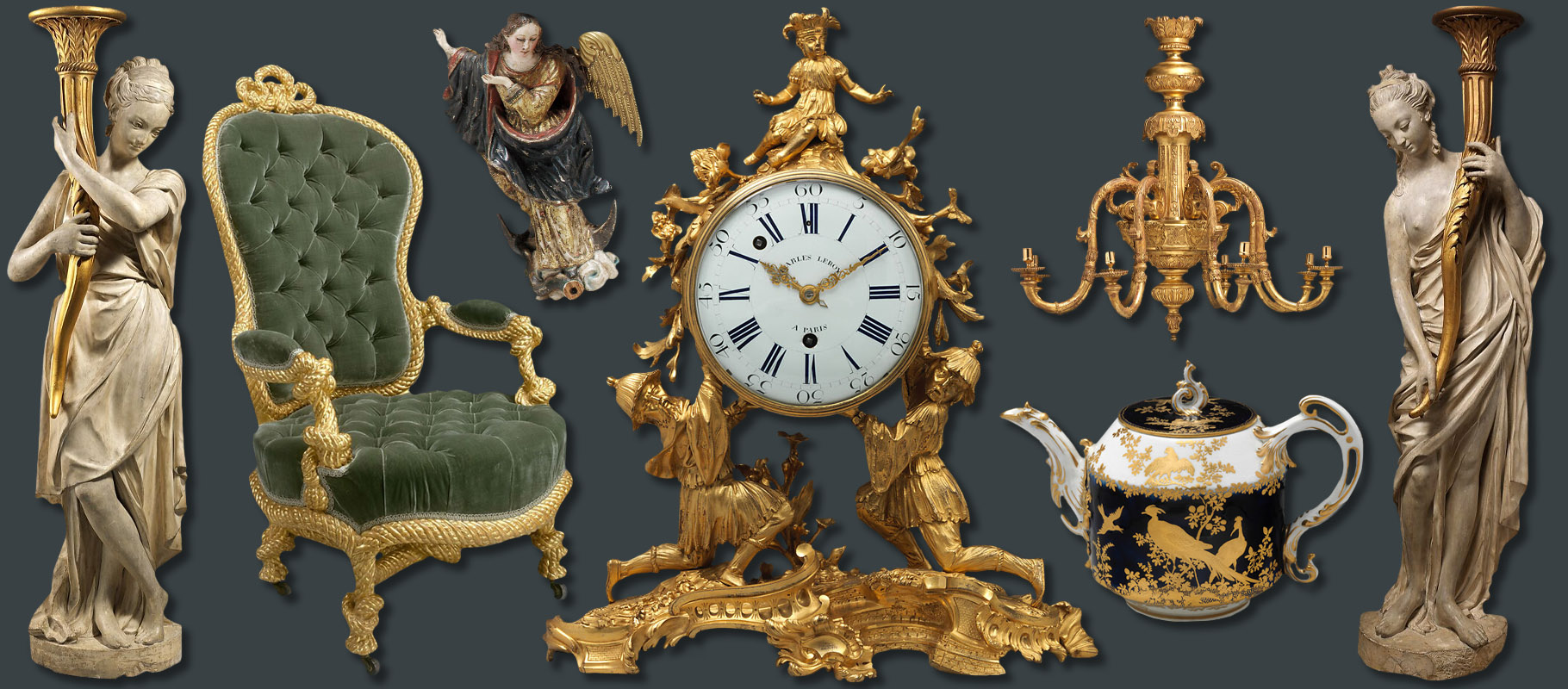 Above: a selection of gilt antiques including a pair of torchère figures, an armchair, a church sculpture, mantle clock, chandelier and Chelsea teapot
Above: a selection of gilt antiques including a pair of torchère figures, an armchair, a church sculpture, mantle clock, chandelier and Chelsea teapot 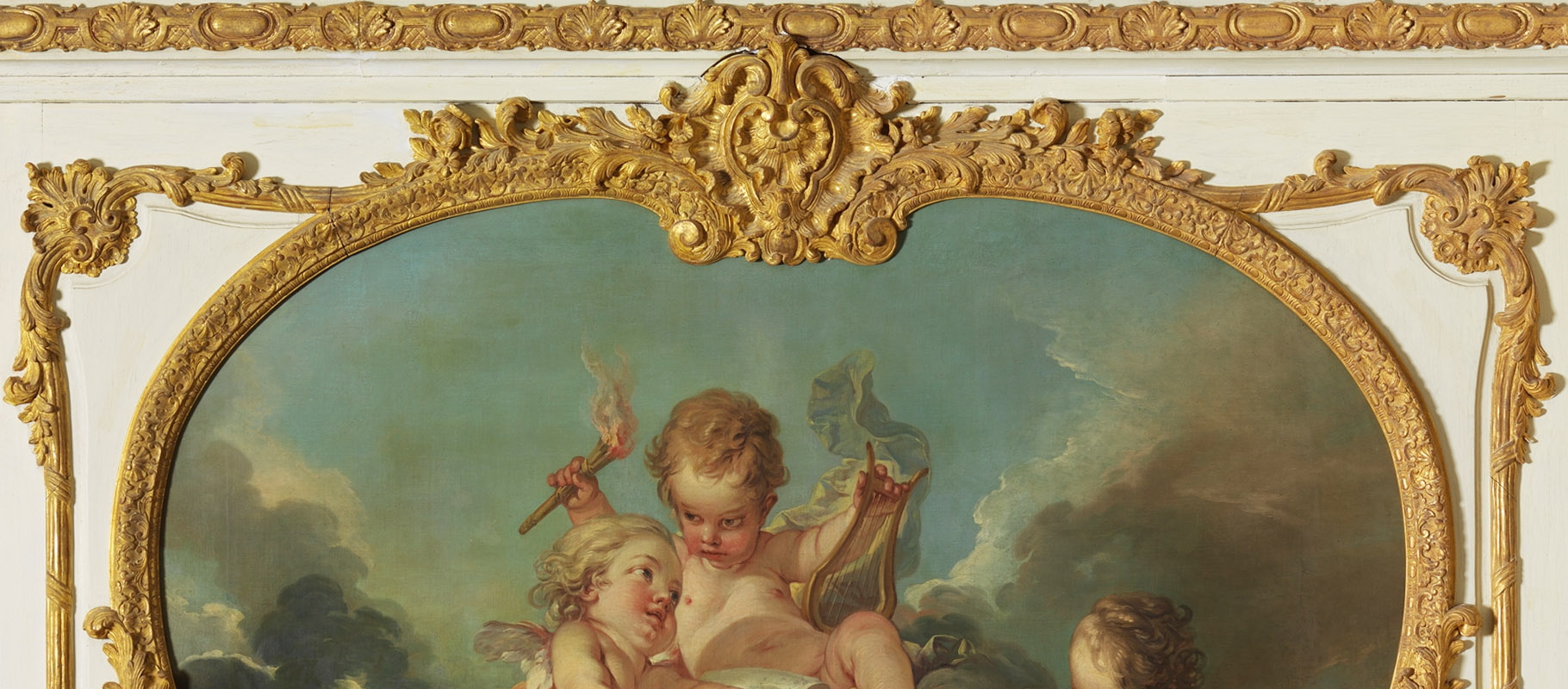 Above: gilt relief decoration surrounding a Boucher panel, 1753
Above: gilt relief decoration surrounding a Boucher panel, 1753 Above: our conservator applying gold leaf
Above: our conservator applying gold leaf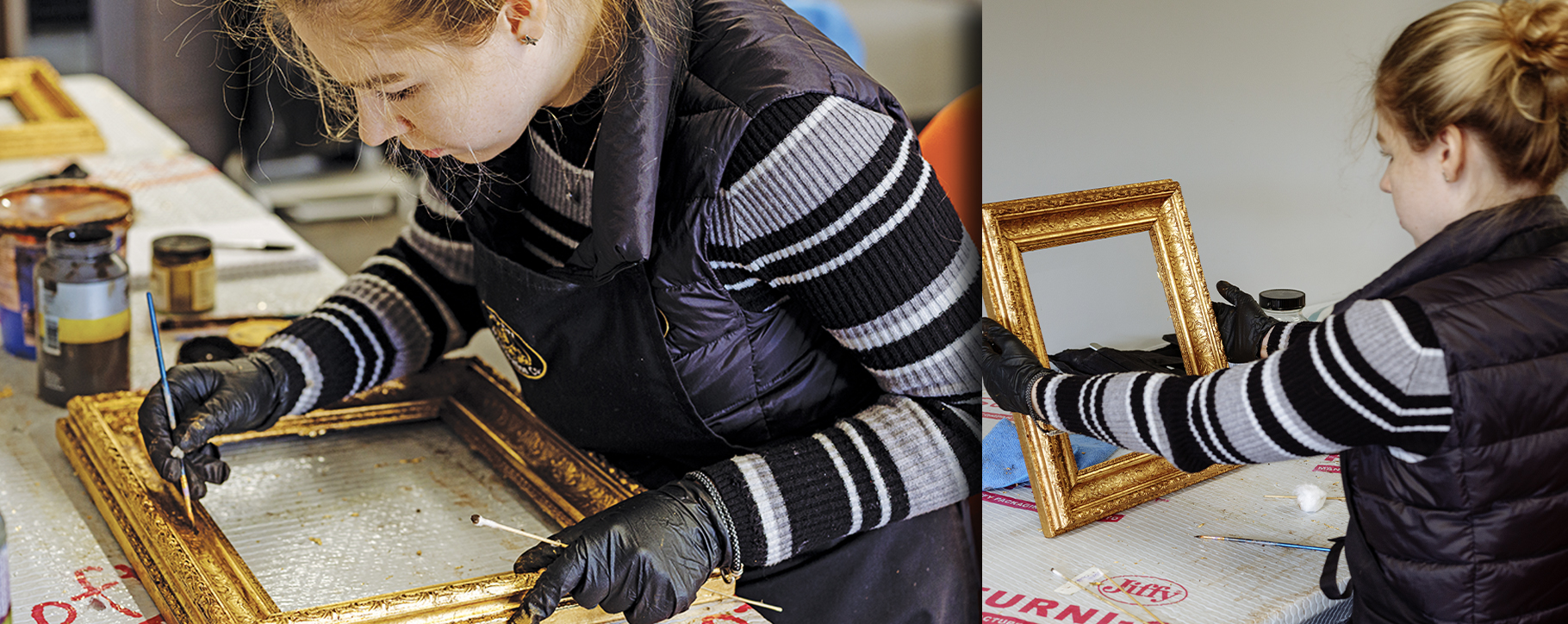 Above: our conservator Amelia adding an aged finish to a newly gilt frame
Above: our conservator Amelia adding an aged finish to a newly gilt frame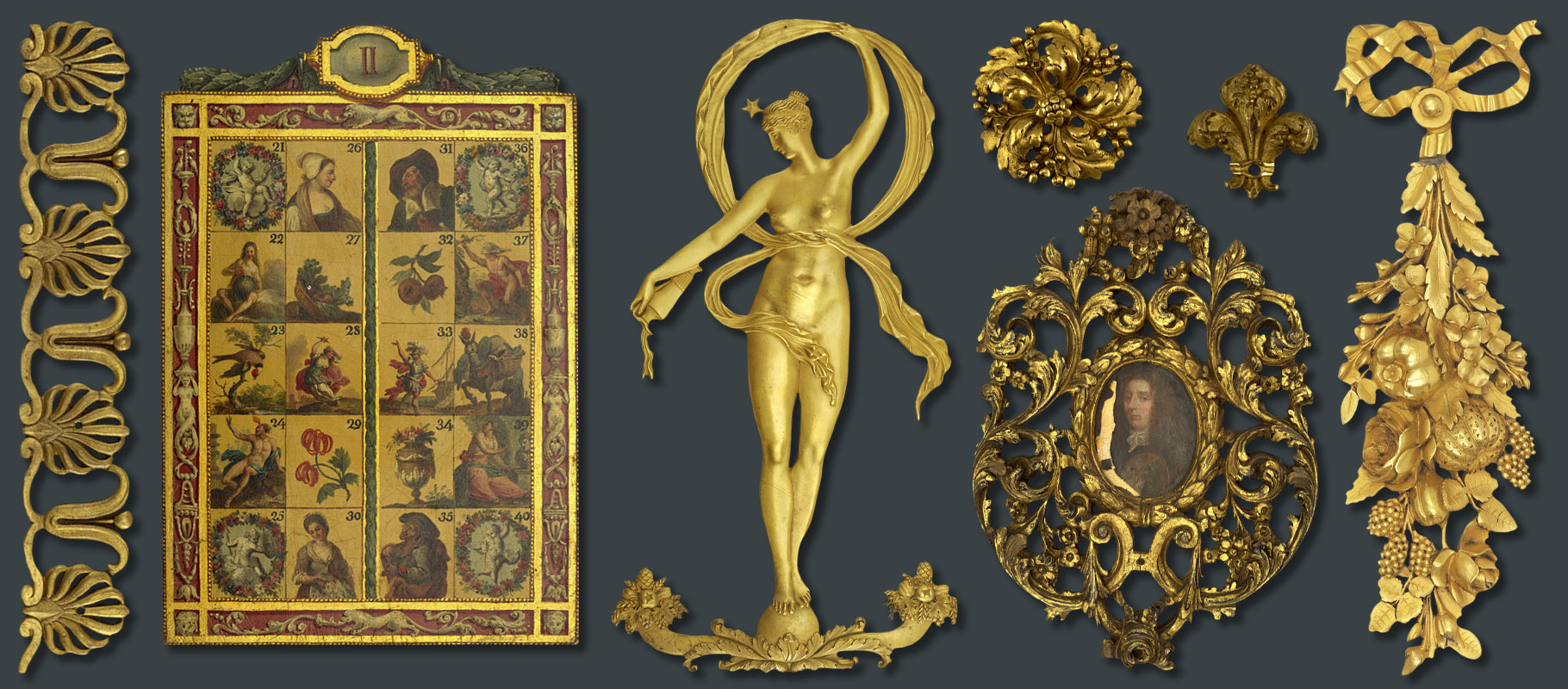 Above: a selection of gilt decorative objects and mouldings
Above: a selection of gilt decorative objects and mouldings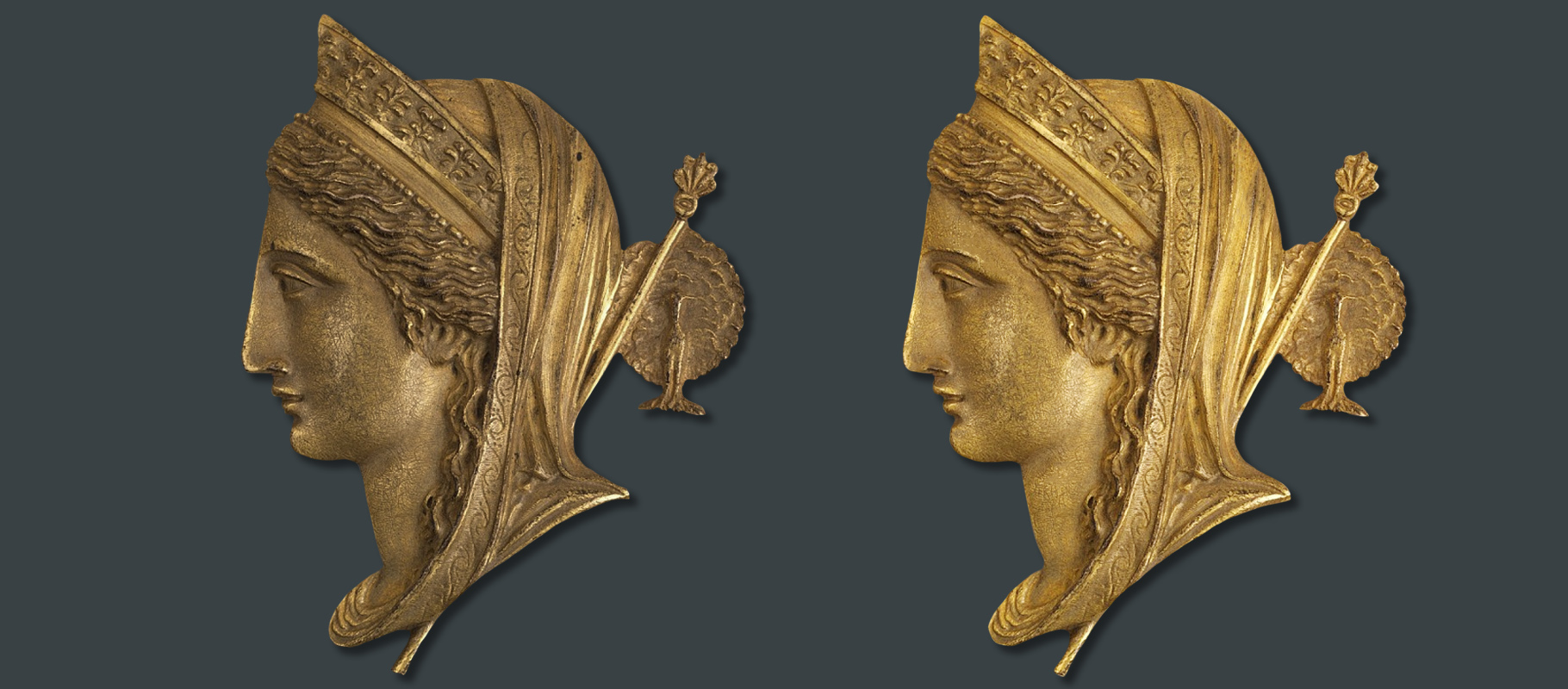 Above: a decorative gilt mount before and after cleaning and restoration
Above: a decorative gilt mount before and after cleaning and restoration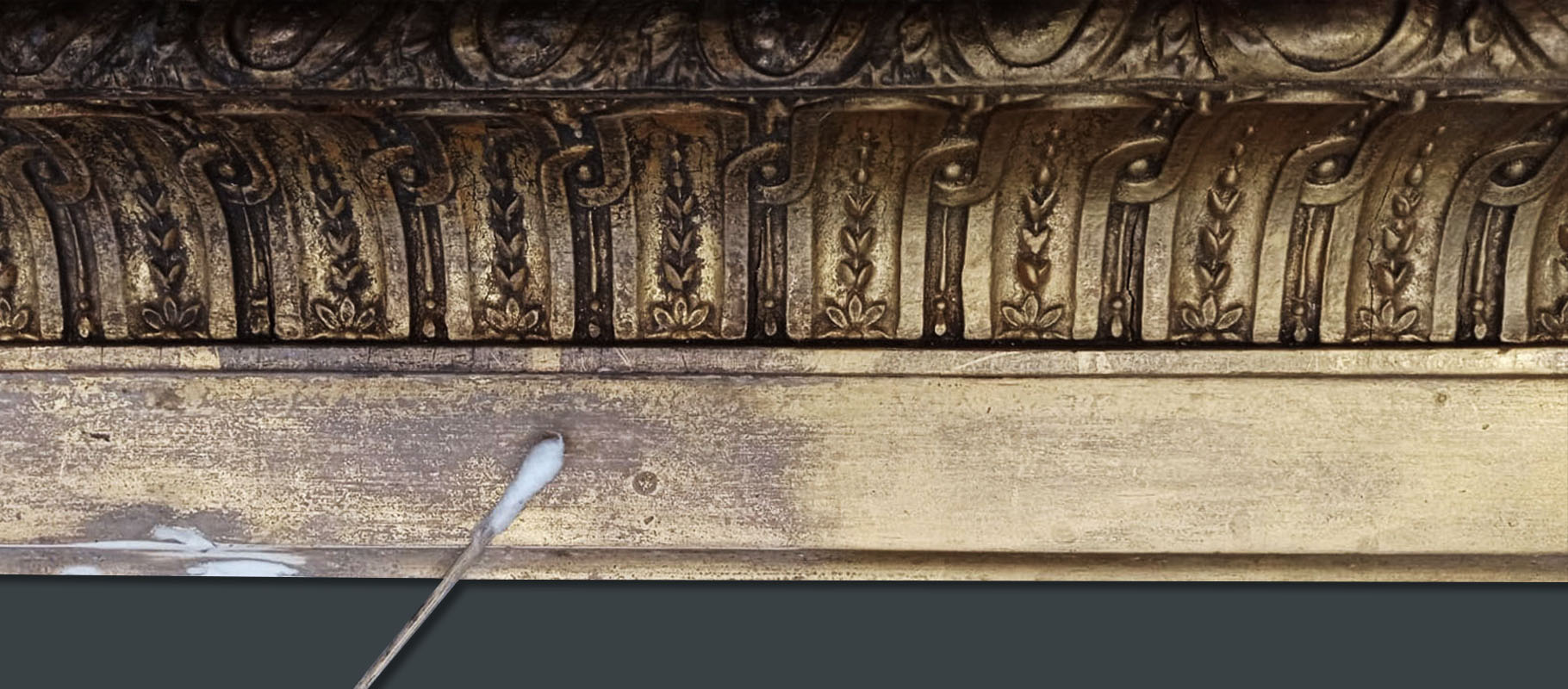 Above: gilt decoration halfway through cleaning in our studio
Above: gilt decoration halfway through cleaning in our studio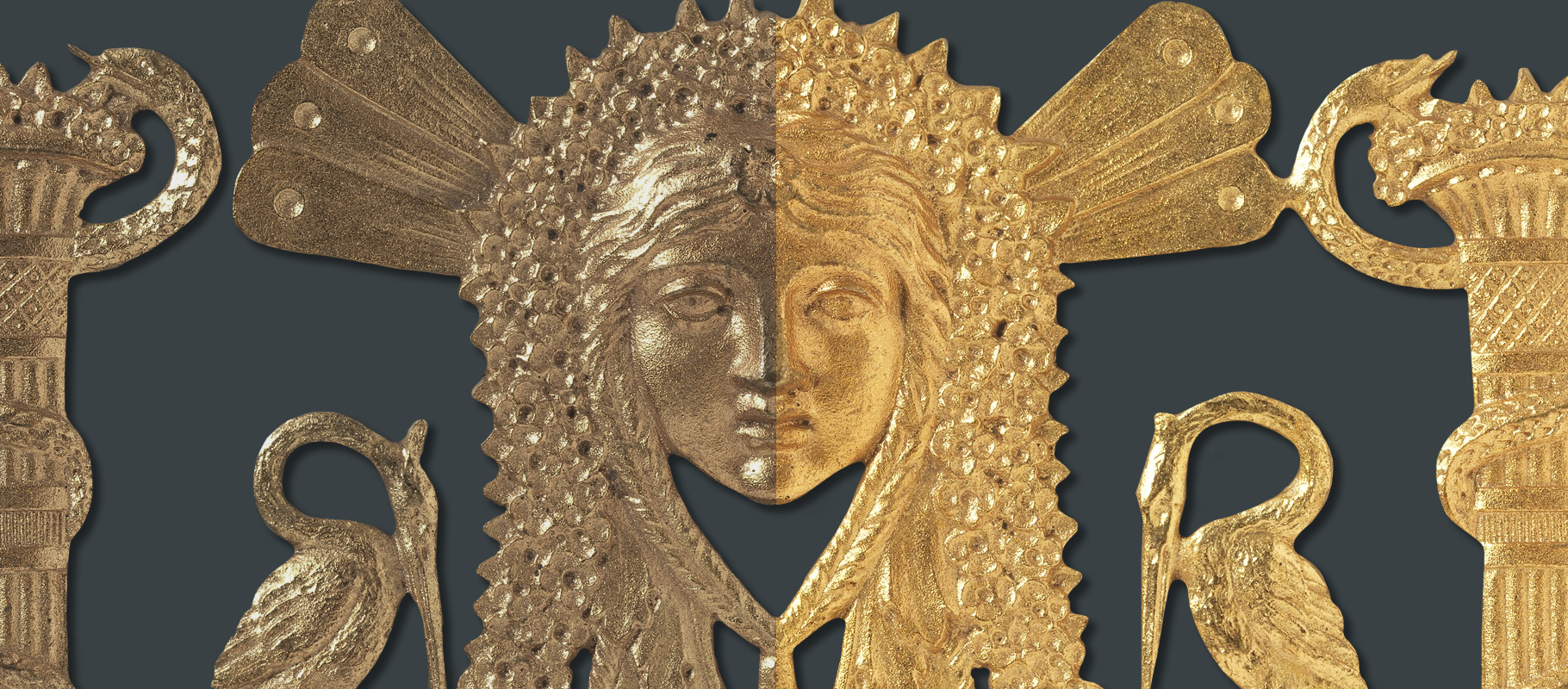 Above: a gilt motif with contrasting levels of gold leaf finish
Above: a gilt motif with contrasting levels of gold leaf finish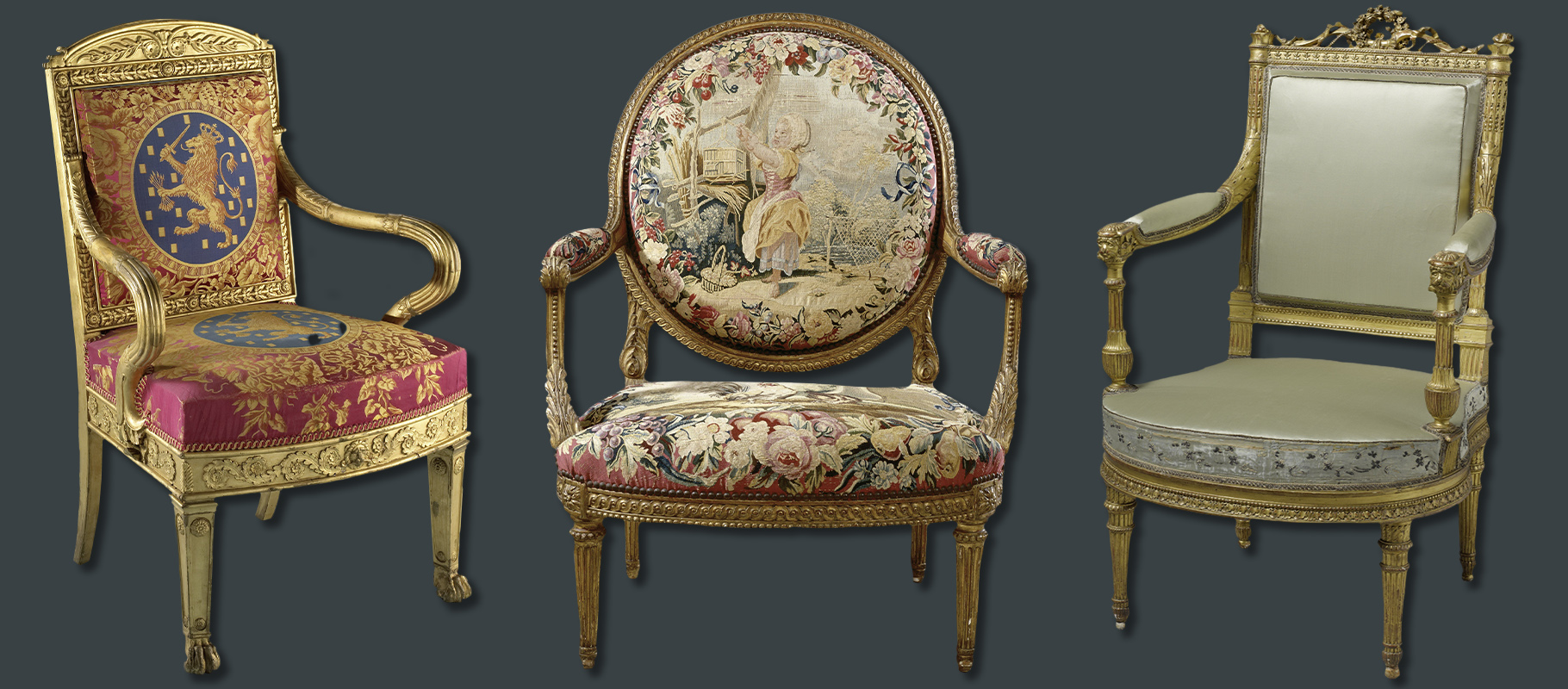 Above: chairs with gold leaf frames are some of the most worn and abraded gilt antiques
Above: chairs with gold leaf frames are some of the most worn and abraded gilt antiques  Above: two guéridon and a side table with gilt decoration
Above: two guéridon and a side table with gilt decoration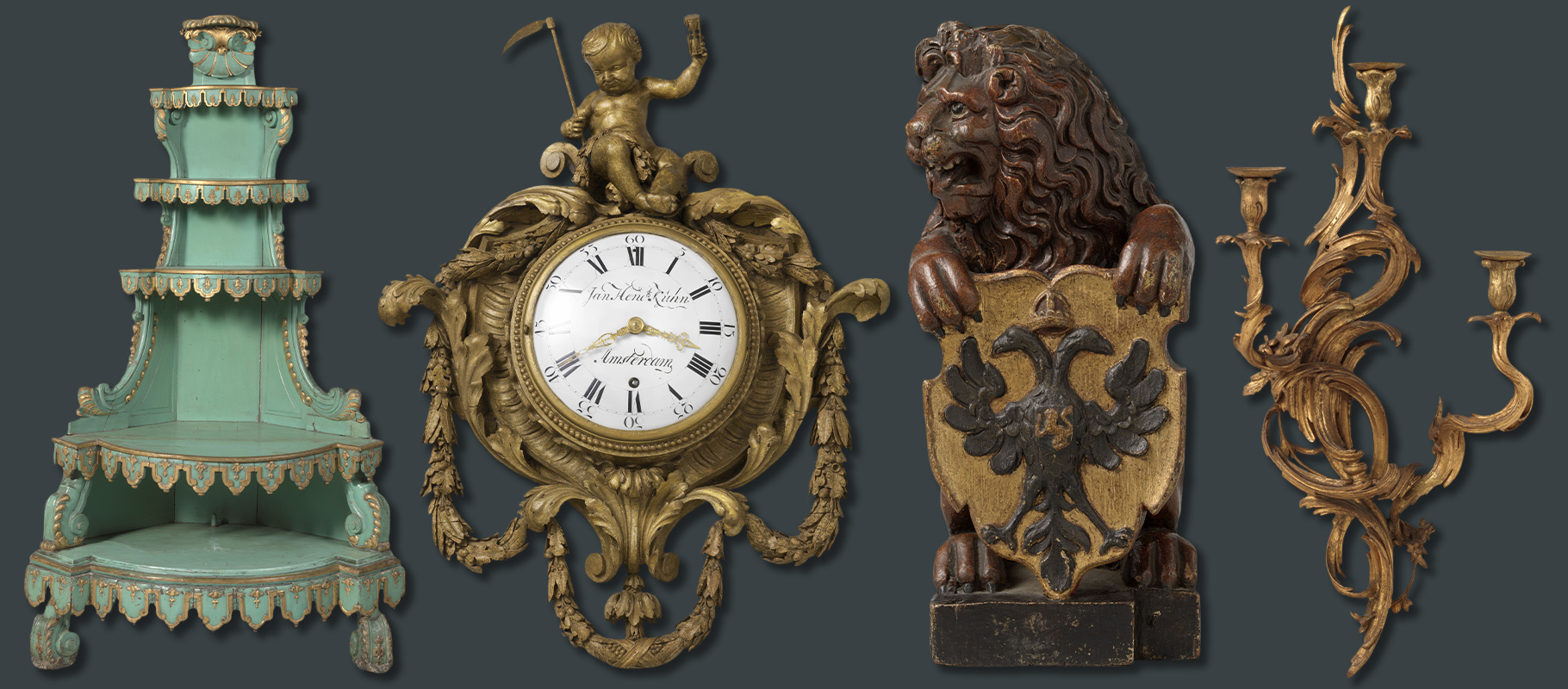 Above: decorative objects with aspects of gold leaf
Above: decorative objects with aspects of gold leaf




